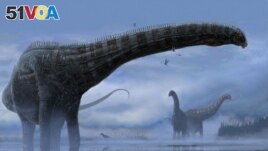17 February 2022
American researchers say they have found the first evidence of a dinosaur being affected by a respiratory sickness.
Scientists say the dinosaur appears to be closely related to the well-known Diplodocus family. The creatures are believed to have lived in the Late Jurassic Period from 163 to 145 million years ago.
Researchers examined the fossilized bones from a diplodocid unearthed in 1990 in the American state of Montana. They found abnormal growths on three neck bones of the dinosaur.

This handout illustration shows a sauropod dinosaur that lived in what is now Montana 150 million years ago during the Late Jurassic Period. (Handout via REUTERS)
The team, which named the remains "Dolly," says it appears the dinosaur may have suffered from a fungal infection similar to aspergillosis. It is a common respiratory sickness that often kills modern birds and reptiles. The sickness can also cause bone infections. The researchers said the condition may have killed Dolly.
Aspergillosis is caused by inhaling particles from a fungus. It is the most common respiratory infection found in birds today. Birds are believed to have evolved from meat-eating, feathered dinosaurs called theropods.
Dinosaurs suffered from sicknesses just like other animals. But evidence of sickness in the fossil record is rare. This is because soft tissue usually does not survive the fossilization process, which favors hard body parts like bone, teeth and claws.
In the past, dinosaur fossils have shown evidence of broken and healed bones, tooth infections, bone conditions and cancer. But, until now, no signs of respiratory infections in dinosaurs have been found.
Cary Woodruff led the research and co-wrote a study about the findings that recently appeared in the publication Scientific Reports. He is the director of paleontology at the Great Plains Dinosaur Museum in Malta, Montana.
Woodruff told Reuters that Dolly was about 18 meters long and weighed about 4 to 5 tons. The dinosaur is thought to have died at between 15 and 20 years of age.
Woodruff said the discovery provides new information about the medical conditions of dinosaurs, as well as details about the anatomical structure of the creature's breathing system.
"I don't personally know of any fossil I've been able to sympathetically relate to more," Woodruff said.
Lawrence Witmer is an anatomist and co-writer of the study. He is with Ohio University Heritage College of Osteopathic Medicine. Witmer told Reuters the dinosaur likely felt a lot of the same symptoms as people do.
"Poor Dolly. She probably felt terrible with all the same signs and symptoms of a lower, respiratory infection that we experience," he said.
Witmer added that there are still unanswered questions about the discovery. "Was Dolly so sick that she couldn't keep up with the herd? Did she die from this disease? Did she die alone?" he said.
Witmer added that the evidence suggests the dinosaur was sick for an extended period. He said the fossils showed Dolly was sick long enough for the condition to cause "reactive bone growth" in the body.
I'm Bryan Lynn.
Reuters reported on this story. Bryan Lynn adapted the report for VOA Learning English.
We want to hear from you. Write to us in the Comments section, and visit 51VOA.COM.
_____________________________________________________________
Words in This Story
respiratory – adj. relating to the process of breathing
fossil – n. part of an animal or plant that lived a long time ago that has been preserved in rock
fungus – n. any one of a group of living things (such as molds, mushrooms, or yeasts) that often look like plants but have no flowers and that live on dead or decaying things
evolve – v. to develop or make something develop over time
claw – n. one of the sharp, curved nails on the feet of some animals and birds
anatomy – n. the scientific study of the body and how its parts are structured
paleontology – n. a science dealing with the life of past geologic periods as known from fossil remains
sympathetic – adj. showing that you understand and care about other people and things
osteopathy – n. the study and treatment of injuries to bones and muscles
symptom – n. a change in the body or mind which indicates that a disease is present